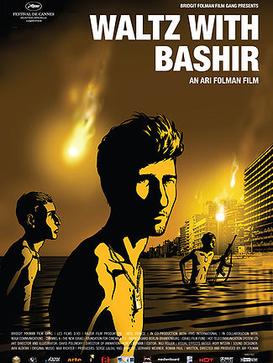The Hebrew spoken film directed by Ari Folman follows the recollections of an infantry soldier in the 1982 war in Lebanon. It uses a mix of traditional and Adobe Flash animation, as well as some 3D techniques in order to create an abstraction to a subject matter that at its core is a heavy one. Waltz with Bashir, that runs at one hour thirty minutes features reoccurring interviewees as the main character, an Israeli film-maker tries to remember his youth at 19 in the war.
The drawn animation appearance is used in conjunction with light documentary style footage. Light in the sense that it does not conform all the time to a documentary, and whilst towards the end comrades and thus interviewees are pinned against a solid blue background; the action scenes are far more cinematic. Waltz with Bashir strays away from a "handycam" documentative style and as such takes on a reflective tone in its execution. Among war veterans, the Israeli film-maker also visits a psychologist, journalist and an accountant. Including these people as an addition to his journey serves not only for the main character to discover more about the terrors of war and the affect it has on people, but for the audience to learn the same. Remarkably, Waltz with Bashir lets on to the brass-tacks of the war in Lebanon without being subjective. At the same time it does not ask for your opinion nor does it project onto the audience its own. However, what is conveyed is that all death no matter who of is a terrible, removed occurrence.

As the film continues it begins to dive more into the psychological aspects of PTSD and the techniques people use in war to distract themselves from the reality they are faced with. By removing themselves from the situation whether that be by pretending they are in a film or are on a long day-trip, they gain some comfort from what is in some ways
too real to even be real. This eventually results in forgetting incidents that are too traumatic.
Waltz with Bashir does not however focus entirely on psychology; and ends with real footage of the aftermath of the massacre in the Lebanon war. There are no subtitles in this final scene; and the very conscious decision to do this as well not animate it to begin with shows the amount of sensitivity Ari Folman took in order to appropriately show the reality of the war. Though banned in Lebanon itself; the film makes strides within itself to stay accurate to real events without dramatizing them for cinematic effect. It could be said that using real footage at the end is a cheap-trick to create a quick surprise, similar to that of a jump-scare but regardless of this, stays true to Waltz with Bashir's aim of educating fairly the effects and facts of the Lebanon war.

















